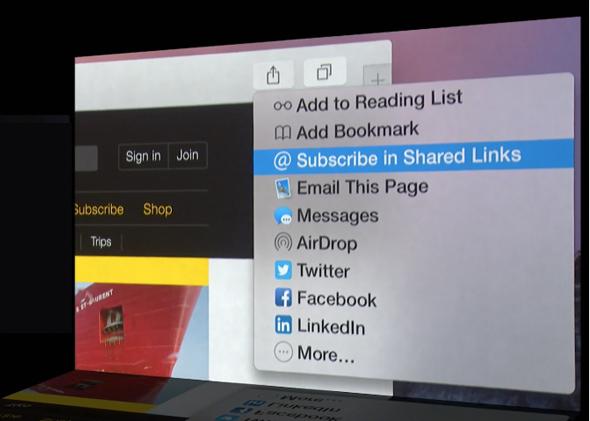Remember the PC wars? Desktops running Windows dominated the market, but Apple’s Macintoshes stubbornly captured small but valuable market share. As a consumer you had to choose sides. Now Apple is involved in a similar battle with Google, but the narrative here is more titans clashing than David and Goliath. Apple’s announcements at WWDC on Monday showed that the company is not just working to match Google’s features, but to go beyond them. You’re going to have to choose sides again very soon.
Numerous features Apple announced are aimed squarely at Google services. First there’s Spotlight. What used to be a way to search local files on your Mac is now much more in Apple’s OS X Yosemite and iOS 8. In Yosemite, Spotlight appears front and center in the middle of the desktop. It searches all your local content as always, and when you search for an application it will also show the files you’ve recently opened with that application. But Spotlight in Yosemite goes a step further. If you search for a movie title, for example, it shows nearby theaters and show times, plus related content streaming from iTunes. And it has Apple Maps integration if you search for a place. Spotlight is basically mimicking features from Google Now info cards, Gmail search, and Google search info cards and presenting them in a different way.
Spotlight is also integrated into the updated Safari browser. You can put a URL into the address bar, or search Google. But the address bar will now also give “Spotlight suggestions.” As you begin typing a prominent public figure’s name, for example, a brief version of their bio shows up in the Spotlight results. Clicking it takes you to their full Wikipedia page.
These Spotlight features are largely contingent on your participation in the total Apple ecosystem. First of all—just to get really basic—you need to have a Mac to run Yosemite. And then you need Yosemite, not an older version of OS X, to get these new Spotlight features. Then you need to use Mail as your email client, iCal as your calendar application, etc. for local data to come up in Spotlight from these applications. And then you need to use Safari to get in-browser Spotlight integration. You have to go all in to reap the benefits—Apple is trying to suck you in for good so you’re not tempted by Google products now or in the future.
Speaking of Safari, Apple’s latest browser update clearly has Google’s Chrome in its sights. Apple knows that people associate Chrome with heavy, multitab browsing, speed, and privacy—so the WWDC keynote was aimed at changing this perception and providing new features to tempt Chrome devotees. For example, even though private browsing windows were popularized by Chrome’s “Incognito Mode,” Craig Federighi, Apple’s senior vice president of software engineering, pointed out that Safari was the first browser to offer private browsing windows (in 2005’s OS X Tiger).
For people doing big projects and/or trying to do a million things at once—which is to say, all of us—Apple has improved Safari’s tabbed browsing experience. There’s a new “Tab View” that shows a bird’s eye view of all your tabs, with tabs from the same website stacked on top of each other. (It’s reminiscent of OS X’s Exposé view.) And you can now scroll back and forth through your tabs in a fluid way that doesn’t feel jerky or disorienting.
Plus the new Safari has a dedicated share button. You can add sites to your RSS feed so they show up in the Safari Sidebar, and you can also send links or specific page elements such as photos with a quick click. A new Markup feature in Yosemite then lets you make little notes or draw on whatever you’re sharing, so you can direct people to the aspect of the content that’s most interesting to you. Again, this demonstrates how you have to use multiple Apple services to get a benefit. Markup seems really convenient, but if you want to use it with Safari sharing, you have to use Mail. And to really take advantage of the RSS feature, you would probably want to use the Safari sidebar as your primary RSS reader, therefore making Safari a much more likely candidate for your default browser.
Apple had Google in mind with other updates as well. IOS 8 finally includes the option to adopt third-party custom keyboards, a longtime favorite feature of Android. Apple also introduced an updated default keyboard called QuickType. It has a predictive typing component that guesses what word you are in the process of typing, and also suggests next words based on meaningful context before you begin typing. And perhaps most revealing—though the keynote breezed past it quickly—Siri can now be voice-activated when an iPhone is in standby mode. All you have to do is say, “Hey, Siri.” So casual! But is it as chill as “OK, Google”? You decide.
There’s a whole world of products out there, but Google and Apple are behind a lot of the ones we pick and choose between every day. You might use Gmail for email, Safari for Web browsing, Google Drive for collaborative office programs, and iPhoto for photo processing and organization. But neither company is happy about that fragmentation. They want everyone to use all of their products. And the only way to bind customers and reduce their ability to choose is to create features that only work for users who are committed to one ecosystem. They may all seem like minor, incremental changes, but whoever offers better perks over time will win.
